An Interference Mitigation Scheme of Device-to-Device Communications for Sensor Networks Underlying LTE-A
Abstract
:1. Introduction
2. D2D Communications in LTE-A Standards
2.1. Proximity Service (ProSe) in LTE-A
2.2. LTE-A Architecture for D2D
2.3. Proximity Discovery Scenarios and Interference
2.4. Resource Allocation for D2D Communications
3. System Model and Proposed Scheme
3.1. System Model
3.2. The Proposed Interference Mitigation Scheme
| Algorithm 1 Operations of the Proposed Scheme. |
|
| Phase1 – Soft FFR by eNB |
|
| Phase2 – ABS by eNB |
|
| Phase3 – Data transmission by DUEs and CUEs |
|
3.2.1. Soft Fractional Frequency Reuse
3.2.2. Almost Blank Sub-Frame
4. Mathematical Modeling and Analysis
4.1. Stochastic Geometry Model for Wireless Sensor Networks
4.2. Channel and Link Distance Models
4.3. Signal-to-Interference-Plus-Noise-Ratio (SINR) Model
4.4. Optimal ABS Ratio
5. Performance Evaluations
5.1. Simulation and Path Loss Models
5.2. Simulation Results
- Scenario 1: Different channel models
- Scenario 2: Different transmission powers
- Scenario 3: Different traffic loads
5.2.1. Scenario 1: Different Channel Model
5.2.2. Scenario 2: Different Transmission Power Levels for CUE and DUE
5.2.3. Scenario 3: Different Traffic Loads for CUE and DUE
6. Conclusions
Acknowledgments
Author Contributions
Conflicts of Interest
References
- Ericsson. More Than 50 Billion Connected Devices; Ericson White Paper; Ericsson: Stockholm, Sweden, 2011. [Google Scholar]
- Cho, S.; Choi, J.W.; You, C. Adaptive multi-node multiple input and multiple output (MIMO) transmission for mobile wireless multimedia sensor networks. Sensors 2013, 13, 13382–13401. [Google Scholar] [CrossRef] [PubMed]
- Evans, D. The Internet of Things How the Next Evolution of the Internet is Changing Everything; Cisco White Paper; Cisco Systems: San Jose, CA, USA, 2011. [Google Scholar]
- Mumtaz, S.; Rodriguez, J. Smart Device to Smart Device Communication; Springer: Cham, Switzerland, 2014. [Google Scholar]
- LG Electronics. Discussion on D2D Discovery Physical Layer Design; LG Electronics: Seoul, Korea, 2014. [Google Scholar]
- Swetina, J.; Lu, G.; Jacobs, P.; Ennesser, F.; Song, J. Toward a standardized common M2M service layer platform: Introduction to oneM2M. IEEE Wirel. Commun. 2014, 21, 20–26. [Google Scholar] [CrossRef]
- OneM2M Alliance. Available online: http://www.onem2m.org/ (accessed on 10 May 2017).
- Feng, J. D2D Communication in LTE-Adavanced Network. Ph.D. Dissertation, Universite de Bretagne-Sud, Lorient, France, 2013. [Google Scholar]
- The Mobile Broadband Standard. Available online: http://www.3gpp.org/DynaReport/FeatureOrStudyItemFile-580038.htm (accessed on 10 May 2017).
- Lin, M.; Ouyang, J.; Zhu, W.P. Joint Beamforming and Power Control for Device-to-Device Communications Underlaying Cellular Networks. IEEE J. Sel. Areas Commun. 2016, 34, 138–150. [Google Scholar] [CrossRef]
- Ma, C.; Liu, J.; Tian, X.; Yu, H.; Cui, Y.; Wang, X. Interference Exploitation in D2D-Enabled Cellular Networks-A Secrecy Perspective. IEEE Trans. Commun. 2015, 63, 229–242. [Google Scholar] [CrossRef]
- Chae, H.S.; Gu, J.; Choi, B.G.; Chung, M.Y. Radio Resource Allocation Scheme for Device-to-Device Communication in Cellular Networks Using Fractional Frequency Reuse. In Proceedings of the 17th Asia-Pacific Conference on Communications (APCC), Sabah, Malaysia, 2–5 October 2011; pp. 58–62. [Google Scholar]
- Zhang, Z.; Hu, R.Q.; Qian, Y.; Papathanassiou, A.; Wu, G. D2D communication underlay uplink cellular network with fractional frequency reuse. In Proceedings of the 11th International Conference on the Design of Reliable Communication Networks (DRCN), Kansas City, MO, USA, 24–27 March 2015; pp. 247–250. [Google Scholar]
- Wu, W.; Zhang, Y. Dedicated resource allocation for D2D communications in cellular systems employing FFR. In Proceedings of the 6th International Conference on Wireless Communications and Signal Processing (WCSP), Hefei, China, 23–25 October 2014; pp. 1–6. [Google Scholar]
- Shah, S.T.; Gu, J.; Hasan, S.F.; Chung, M.Y. SC-FDMA-based resource allocation and power control scheme for D2D communication using LTE-A uplink resource. EURASIP J. Wirel. Commun. Netw. 2015, 1, 1–15. [Google Scholar] [CrossRef]
- 3GPP TR 23.703. Available online: http://www.arib.or.jp/english/html/overview/doc/STD-T63v11_00/5_Appendix/Rel12/23/23703-c00.pdf (accessed on 10 May 2017).
- 3GPP TS 23.303 v12.2.0 Release 12. Available online: http://www.etsi.org/deliver/etsi_ts/123300_123399/123303/12.02.00_60/ts_123303v120200p.pdf (accessed on 10 May 2017).
- Chen, Y.F.; Ding, W.S.; Wang, L.C. Hybrid Protected Subframes Resource Allocation and Throughput Estimation in LTE-A HetNet. In Proceedings of the IEEE International Conference on Internet of Things, Green Computing and Communications (GreenCom), and Cyber, Physical and Social Computing (CPSCom), Taipei, Taiwan, 1–3 September 2014; pp. 567–571. [Google Scholar]
- Kshatriya, S.N.S.; Kaimalettu, S.; Yerrapareddy, S.R.; Milleth, K.; Akhtar, N. On interference management based on subframe blanking in heterogeneous LTE networks. In Proceedings of the 5th International Conference on Communication Systems and Networks (COMSNETS), Bangalore, India, 7–10 January 2013; pp. 1–7. [Google Scholar]
- Jiang, L.; Lei, M. Resource allocation for eICIC scheme in heterogeneous networks. In Proceedings of the IEEE 23rd International Symposium on Personal, Indoor and Mobile Radio Communications (PIMRC), Sydney, Australia, 9–12 September 2012; pp. 448–453. [Google Scholar]
- Ma, C.; Wu, W.; Cui, Y.; Wang, X. On the performance of successive interference cancellation in D2D-enabled cellular networks. In Proceedings of the IEEE Conference on Computer Communications (INFOCOM), Kowloon, Hong Kong, China, 26 April–1 May 2015; pp. 37–45. [Google Scholar]
- Lin, X.; Andrews, J.G. Optimal spectrum partition and mode selection in device-to-device overlaid cellular networks. In Proceedings of the IEEE Global Communications Conference (GLOBECOM), Atlanta, GA, USA, 9–13 December 2013; pp. 1837–1842. [Google Scholar]
- Lin, X.; Ratasuk, R.; Ghosh, A.; Andrews, J.G. Modeling, analysis, and optimization of multicast device-to-device transmissions. IEEE Trans. Wirel. Commun. 2014, 13, 4346–4359. [Google Scholar] [CrossRef]
- Ye, Q.; Al-Shalash, M.; Caramanis, C.; Andrews, J.G. Device-to-device modeling and analysis with a modified Matern hardcore BS location model. In Proceedings of the IEEE Global Communications Conference (GLOBECOM), Atlanta, GA, USA, 9–13 December 2013; pp. 1825–1830. [Google Scholar]
- Ghosh, R.; Ratasuk, R. Essentials of LTE and LTE-A; Cambridge University Press: Cambridge, UK, 2011. [Google Scholar]
- Guidelines for Evaluation of Radio Interface Technologies for IMT-Advanced. Available online: http://www.itu.int/pub/R-REP-M.2135 (accessed on 10 May 2017).
- Xing, H.; Hakola, S. The investigation of power control schemes for a device-to-device communication integrated into OFDMA cellular system. Proceedings of 21st Annual IEEE International Symposium on Personal, Indoor and Mobile Radio Communications (PIMRC), Istanbul, Turkey, 26–30 September 2010; pp. 1775–1780. [Google Scholar]
- Raheem, R.; Lasebase, A.; Loo, J. Performance Evaluation of LTE networking via using Fixed/Mobile Femtocells. In Proceedings of the 28th International Conference on Advanced Information Networking and Applications Workshops, Victoria, BC, Canada, 13–16 May 2014. [Google Scholar]
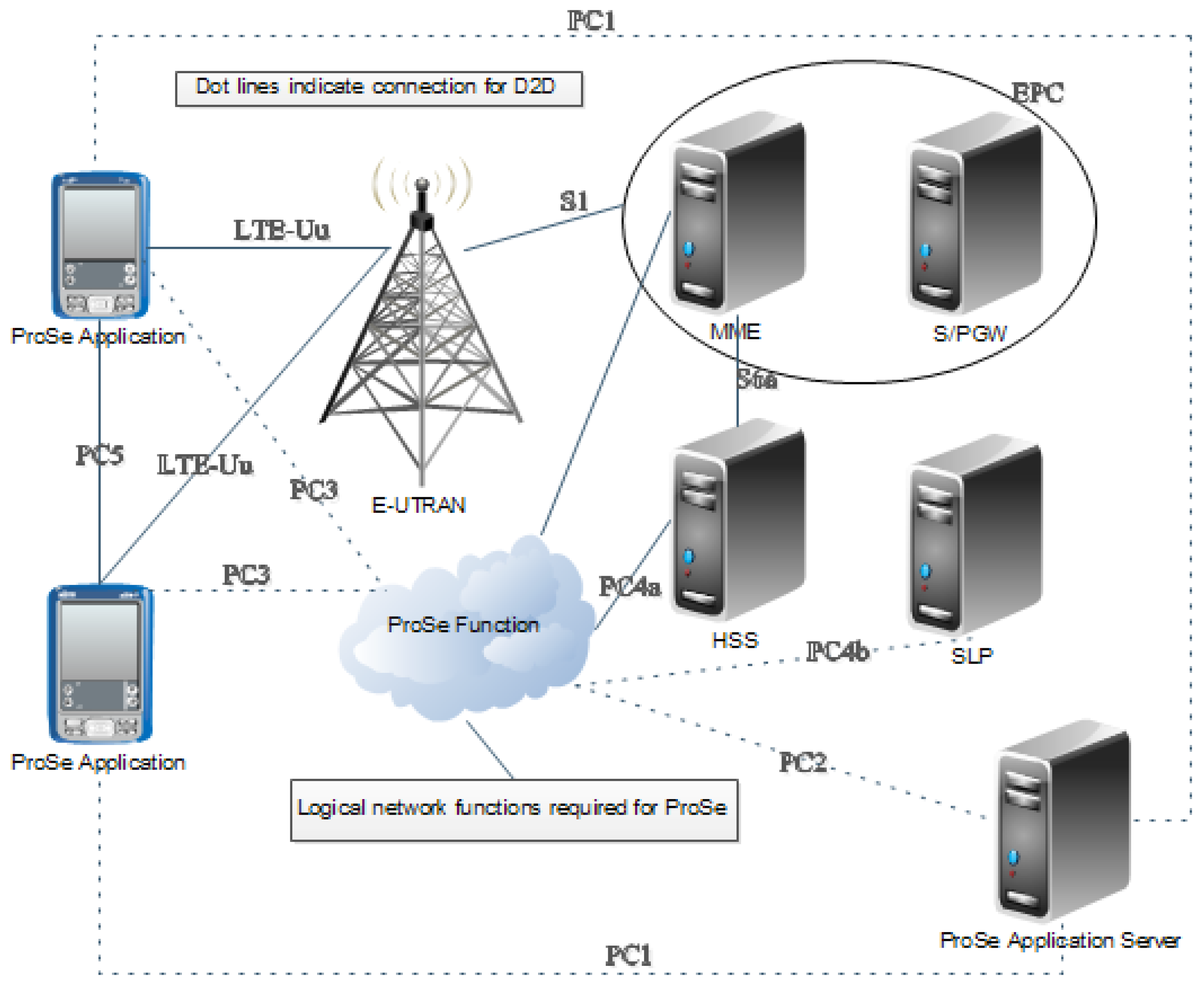

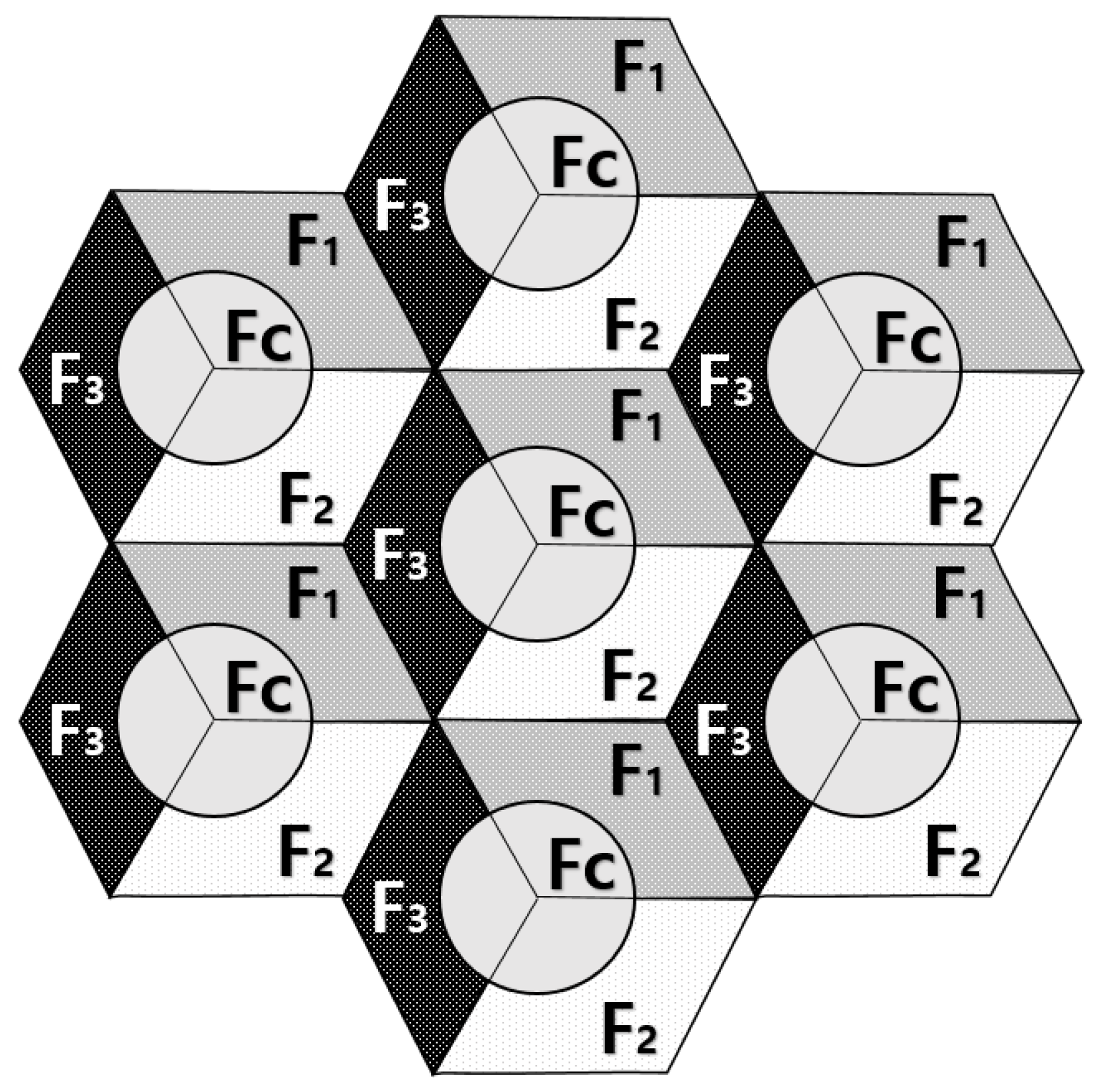
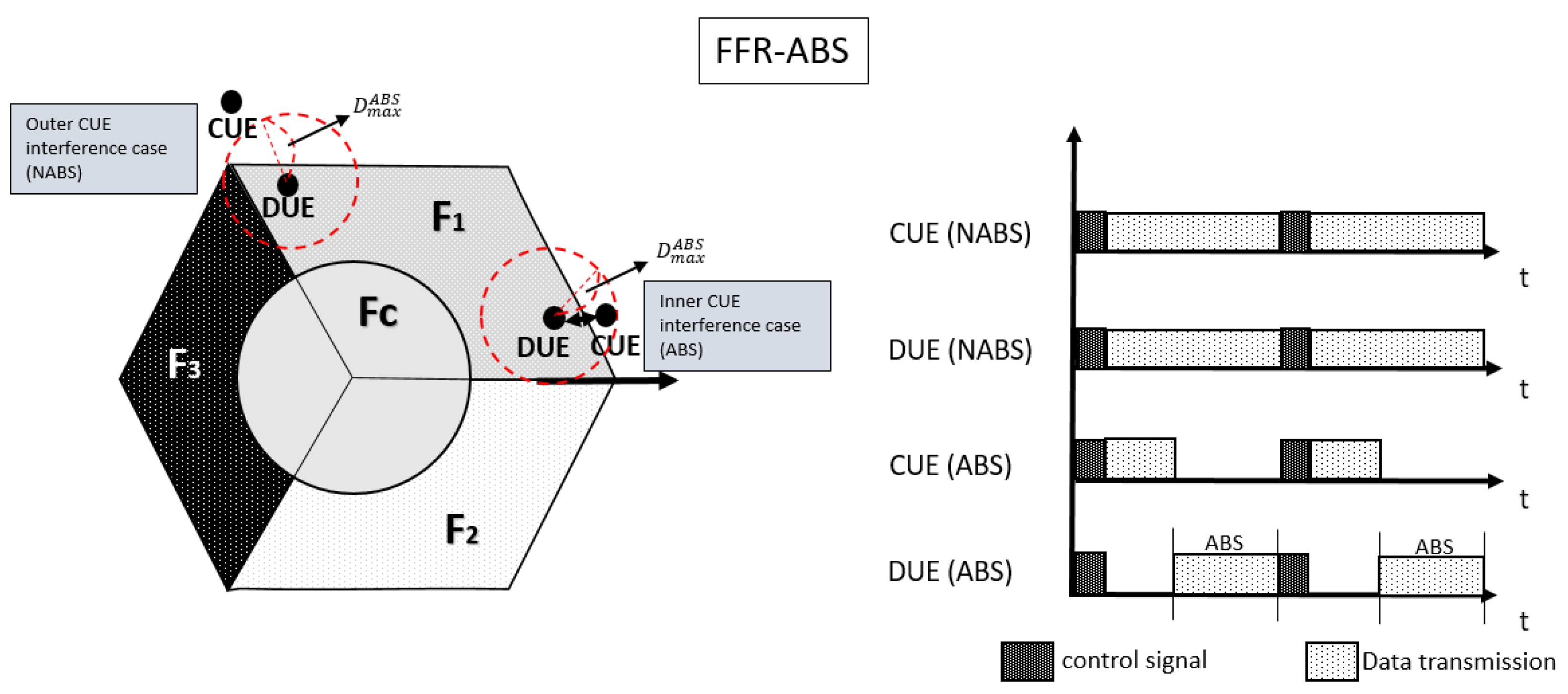


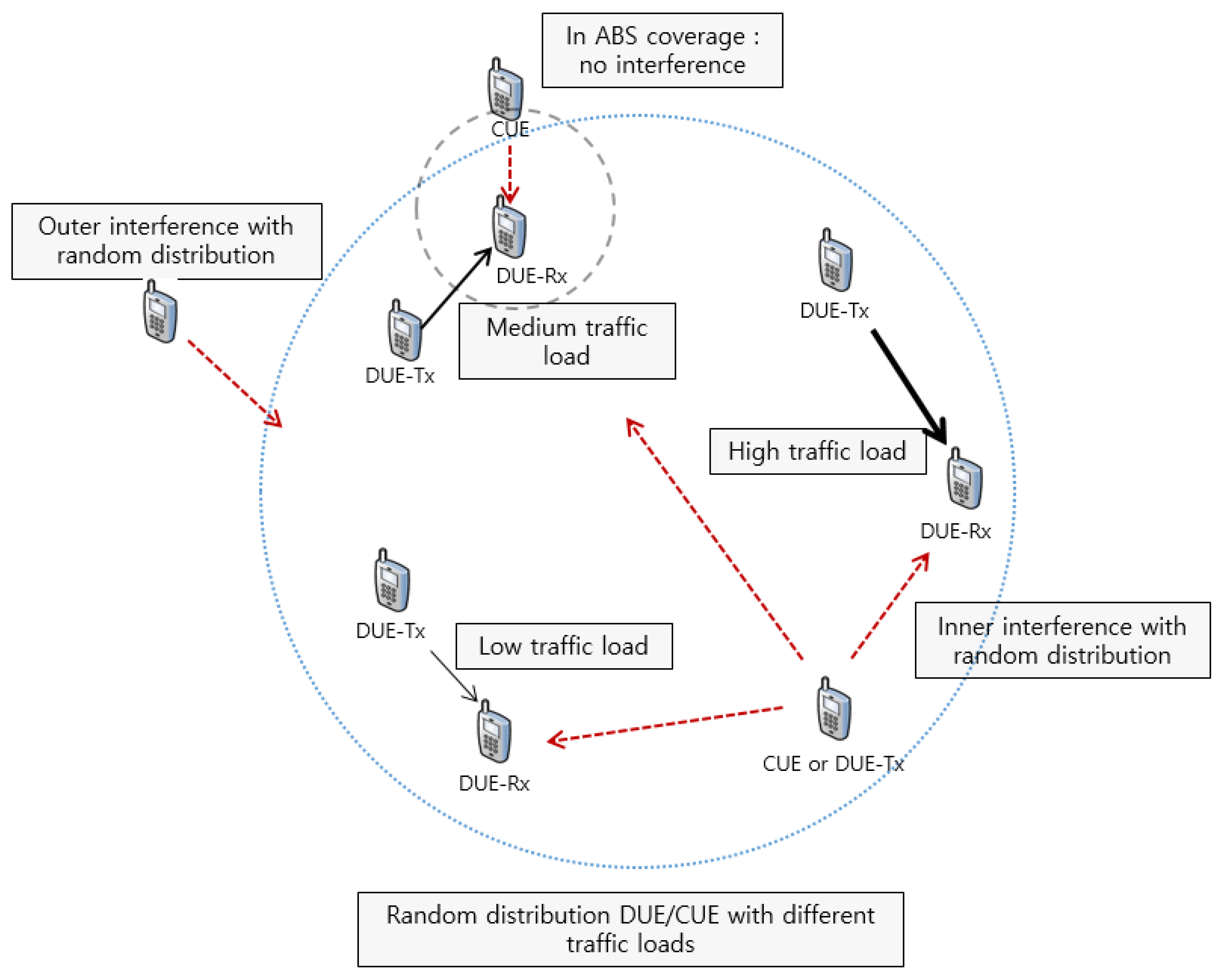
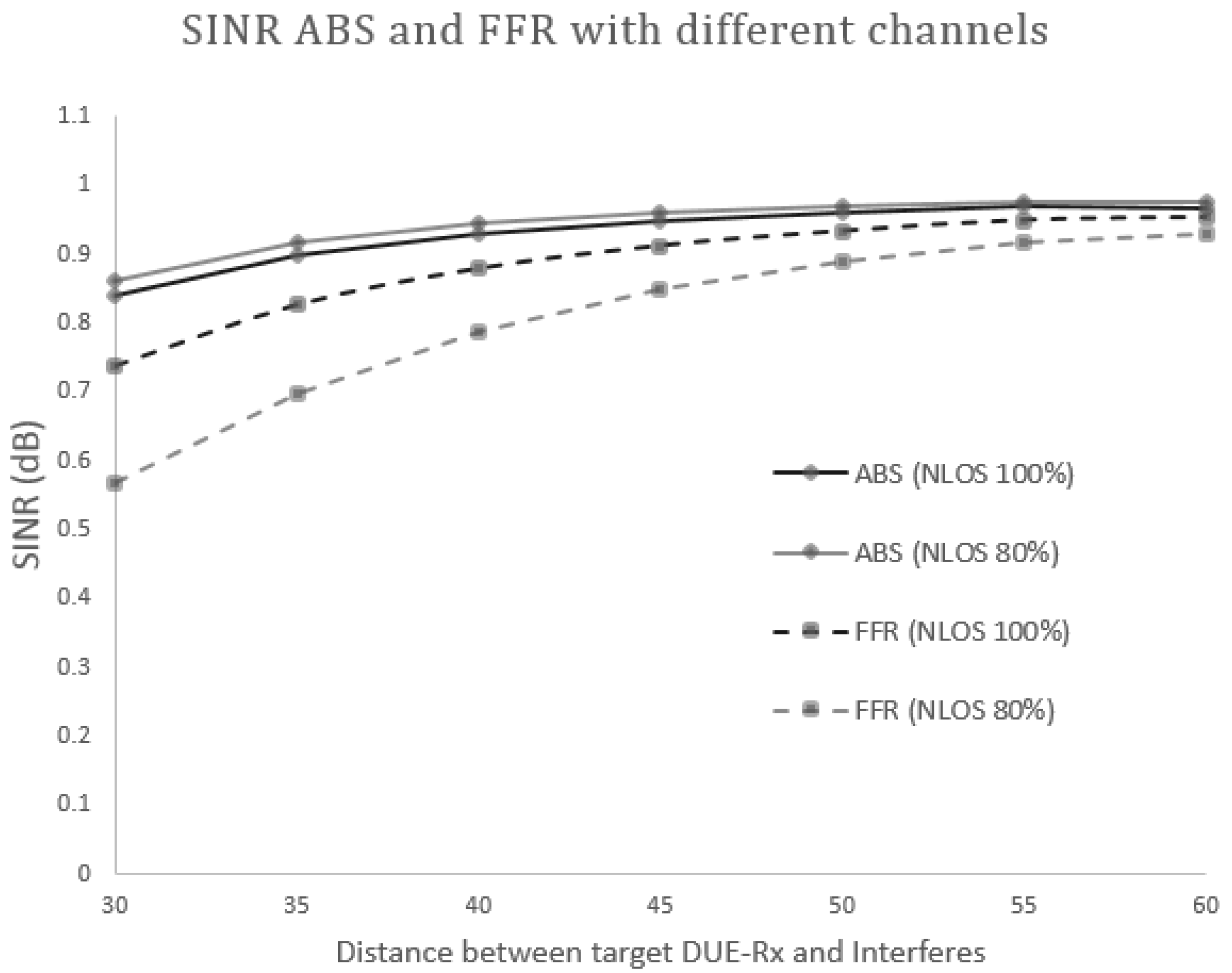
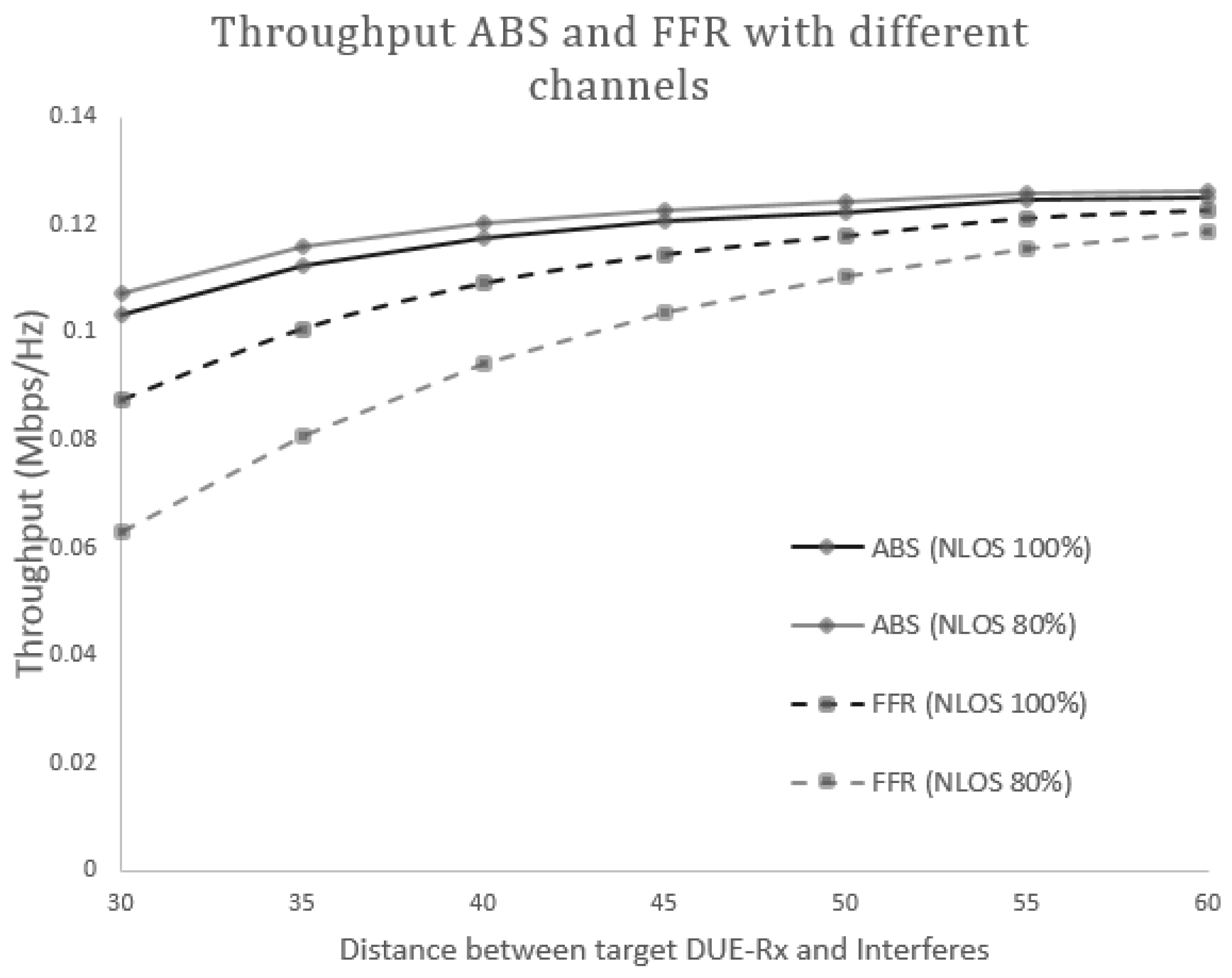
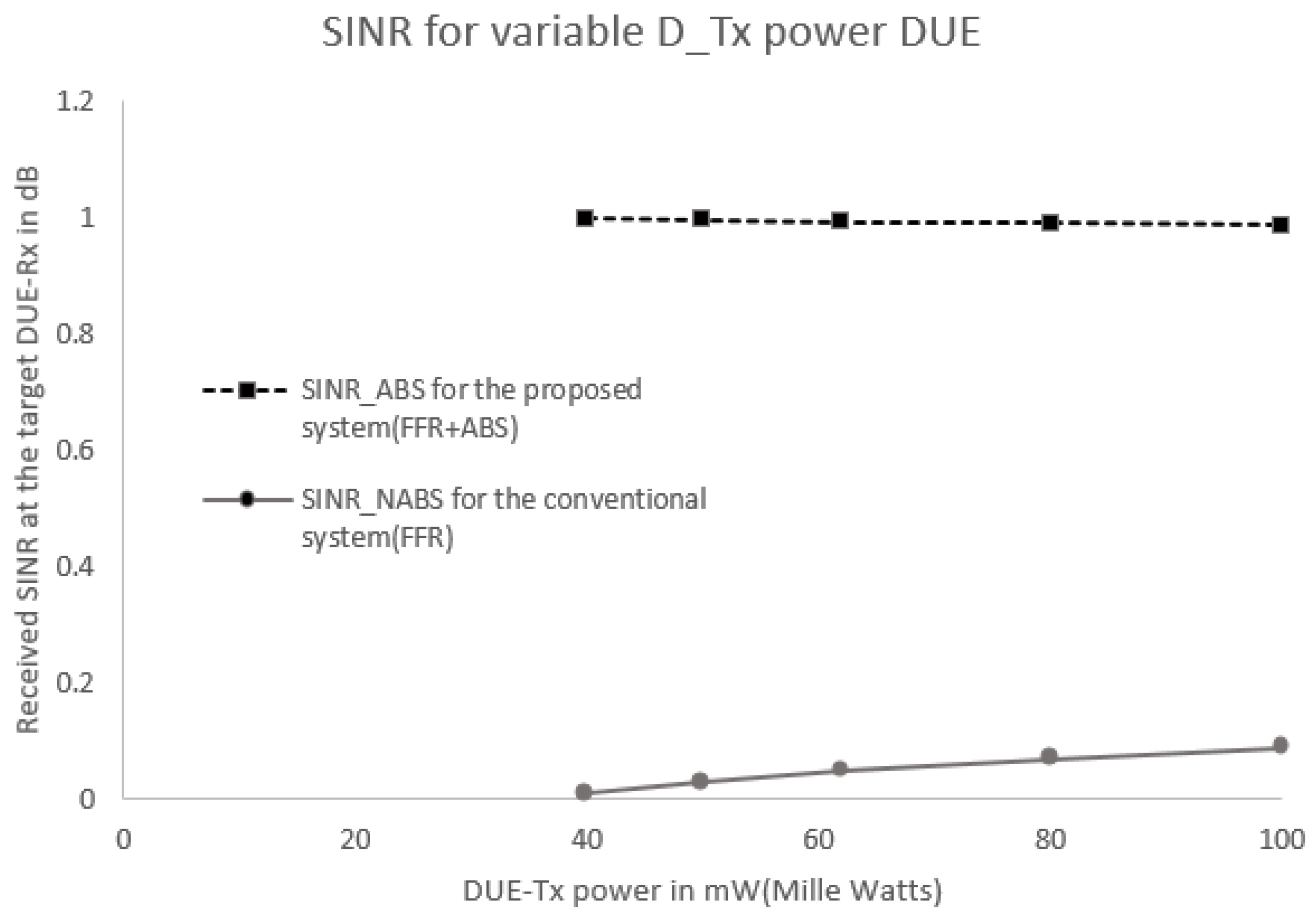


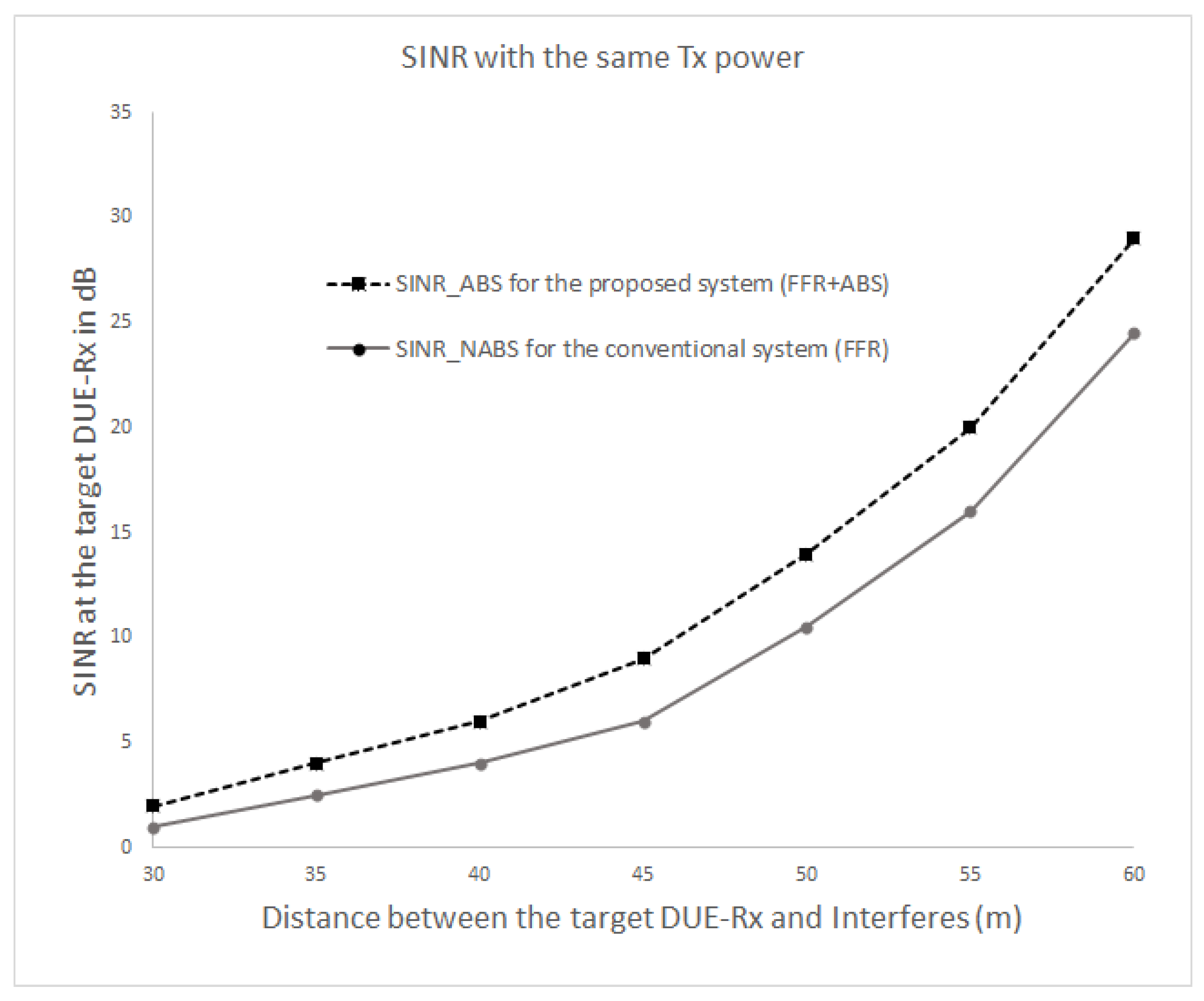


| UE1 | UE2 | Serving Cell | Communication Path | Interference Sources | |
|---|---|---|---|---|---|
| 1A | Out | Out | n/a | direct | n/a |
| 1B | In | Out | n/a | direct | Cellular User Equipments (CUEs) in the same cell |
| 1C | In | In | Same cell | direct | Cellular User Equipments (CUEs) in the same celland D2D User Equipments (DUEs) in the same celland neighboring cells |
| 1D | In | In | Different cell | direct | Cellular User Equipments (CUEs) in the same celland D2D User Equipments (DUEs) in the same celland neighboring cells |
| Area | Partition | Frequency | CUE | D2D |
|---|---|---|---|---|
| Cell-Center | , and | |||
| Cell-Edge | , and | |||
| Cell-Edge | , and | |||
| Cell-Edge | , and |
| Notation | Definition |
|---|---|
| Homogeneous point processes (PPP) for eNB distribution | |
| Homogeneous point processes (PPP) for CUE distribution | |
| Homogeneous point processes (PPP) for DUE-Tx distribution | |
| Intensity of homogeneous point processes (PPP) for eNB distribution | |
| Intensity of homogeneous point processes (PPP) for CUE distribution | |
| Intensity of homogeneous point processes (PPP) for DUE-Tx distribution | |
| , | Complex channel gain between node x to y for cellular and D2D links, respectively |
| , | A set of K DUE-Tx/DUE-Rx terminals using D2D links for frequency |
| A set of C UE using cellular links for frequency | |
| , | The minimum/maximum distance between DUE-Tx and DUE-Rx, respectively |
| Maximum distance between CUE and DUE-Rx for adopting ABS scheme | |
| A set of CUEs whose distance from DUE-Rx j is less than | |
| A set of DUEs whose distance from CUE j is less than | |
| Additive White Gaussian Noise (AWGN) noise variance | |
| , | Transmission power for CUE and DUE-Tx, respectively |
| ABS pattern ratio |
| Parameter | Assumption/Value |
|---|---|
| Cellular layout | Hexagonal grid, 7 cells sites |
| Path Loss Model (D2D-NLOS 100%) | |
| Path Loss Model (D2D-NLOS 80%) | |
| Path Loss Model (CUE-NLOS 100%) | |
| Path Loss Model (CUE-NLOS 80%) | |
| CUE transmit power | 24 dBm |
| DUE transmit power | 20 dBm |
| Noise power density | dBm |
| Inter-site distance (radius of the cell) | 500 m |
| Carrier frequency | 2 GHz |
| Bandwidth | 10 MHz |
| Number CUEs | 10 |
| Number of DUE | 20 |
| ABS pattern period | 10 ms |
| Distance between D2D | 20–60 m |
| Traffic patterns | Full-buffered |
| Monte Carlo number | 10,000 |
© 2017 by the authors. Licensee MDPI, Basel, Switzerland. This article is an open access article distributed under the terms and conditions of the Creative Commons Attribution (CC BY) license (http://creativecommons.org/licenses/by/4.0/).
Share and Cite
Kim, J.; Karim, N.A.; Cho, S. An Interference Mitigation Scheme of Device-to-Device Communications for Sensor Networks Underlying LTE-A. Sensors 2017, 17, 1088. https://doi.org/10.3390/s17051088
Kim J, Karim NA, Cho S. An Interference Mitigation Scheme of Device-to-Device Communications for Sensor Networks Underlying LTE-A. Sensors. 2017; 17(5):1088. https://doi.org/10.3390/s17051088
Chicago/Turabian StyleKim, Jeehyeong, Nzabanita Abdoul Karim, and Sunghyun Cho. 2017. "An Interference Mitigation Scheme of Device-to-Device Communications for Sensor Networks Underlying LTE-A" Sensors 17, no. 5: 1088. https://doi.org/10.3390/s17051088







